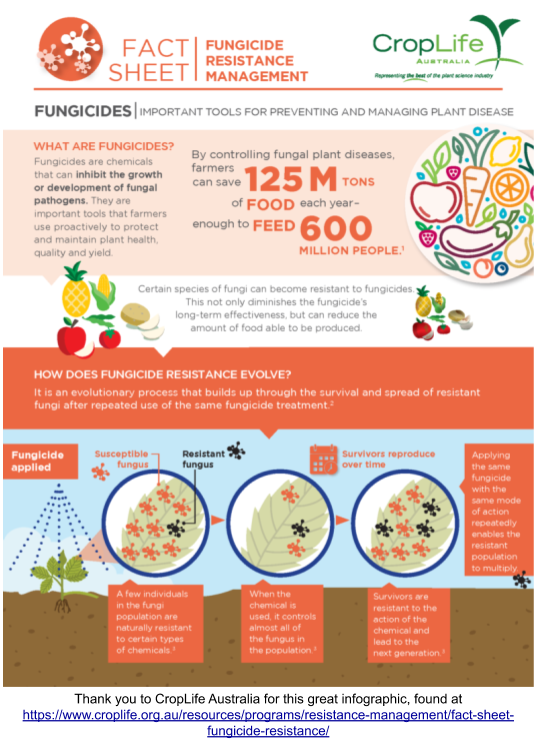
Author: Lisa Rothmann
Universtiy of the Free State UFS
Department of Plant Science, Plant Pathology
Edited: Marlese Meiring, UFS.
What are fungicides...
Fungicides, agrochemicals controlling fungal pathogens, have contributed relief to crop management systems for centuries, protecting yields and assisting in providing uncompromised quality. Over time, many new chemistries with novel structures and systemic activity have been developed, providing a more potent effect on disease control. The application methods and optimised timing of fungicides have evolved alongside these technologies, in combination with an integrated pest management strategy, using complimentary non-chemical interventions, to minimise the effects of crop diseases. While hundreds of fungicidal compounds exist, few target crop-pathogen specific needs effectively and reliably Brent & Hollomon, 2007.
Registered actives
In South Africa, there are limited registered active ingredients to manage diseases caused by Sclerotinia sclerotiorum. Benomyl is registered as a sunflower seed treatment. The remaining active ingredients listed are recommended for application at early bloom, ~1 to 20% flowering depending on the crop. Procymidone is registered for the application on dry bean, green bean, soybean and pea. Sclerotinia stem rot management of canola is possible with either azoxystrobin or a prothioconazole + tebuconazole combination. While leafy vegetables, such as lettuce, can be controlled with a combination of cyprodinil + fludioxonil (AVCASA, 2018). Registered products are applied at different application frequencies in fields due to the nature of disease variation between provinces, as a result of pathogen virulence and inoculum potential, host susceptibility and environmental conduciveness.
Defining funcide resistance?
Fungi which are successfully controlled by fungicides are known as ‘sensitive’ to the active ingredient, thus the pathogen will be negatively affected and crop protected. In contrast, pathogens which are not affected by the fungicide are known to be ‘insensitive’ or ‘naturally resistant’, in turn, the product will not provide sufficient protection to the host. When an active ingredient or product with a similar mode of action (MoA, how an active ingredient functions to target and bind to an organism) or mixture is used for prolonged periods inevitably pathogens may no longer be effectively controlled by a once adequate product Brent & Hollomon, 2007. In this process, the pathogen ‘acquires resistance’ through the emergence, selection and adjustment of pathogen genetics to the pressure imposed on them to survive Brent & Hollomon, 2007, van den Bosch et al., 2011).
Fungicide resistance observed in S. sclerotiorum
Field resistance of plant disease fungal pathogens is known to develop against fungicides, threatening the effectiveness and future use of products FRAC, 2019. Sclerotinia sclerotiorum has various sensitivity to fungicide application in the field. In Brazil, procymidone is used extensively to control Sclerotinia rot of common bean. Brazilian isolates of S. sclerotiorum indicated low to rare levels of resistance, however, resistance management practices were suggested to reduce the likelihood of spread of fungicide resistant genotypes of the pathogen (Lehner et al., 2015). The control of canola stem rot in China is managed with the application of dimethachlon (a dicarboximide, the same fungicide group as procymidone). Chinese isolates collected and evaluated indicated resistance or insensitivity to the fungicide applications in the laboratory and in field trials. This dilemma has left the Chinese to find alternate MoAs to control stem rot of canola, as the effectiveness of the dimethachlon is threatened by the resistance observed (Ma et al., 2009). Using just these two examples, it is critical that fungicide resistance to local pathogens, local environments and local crop genotypes be considered. In Brazil, fungicide resistance to procymidone was rare in contrast to observations in China, where an active ingredient from the same fungicide group indicated fungicide resistance and did not provide sufficient control.
The Fungicide Action Resistance Committee (FRAC) was established in 1994 to address issues surrounding resistance management and provide countermeasures to reduce or delay resistance. Fungicide resistance is a complex and devastating occurrence (likely inevitable in modern agricultural practices) and should be considered by all crop management specialists when developing a disease control system Brent & Hollomon, 2007.
For the full reference list please contact the author.